
I had seen it before, those fuzzy, furry leaves and stalks, with the pretty, star-pointed purple flowers, but up until that moment that I saw them sitting in a basket at the market stalls, I admit I had never taken notice of it as a food. It grow along cracks in stone walls and along the roadside near my home in Settignano, which is blooming with spring goodness right now: robinia (black locust) trees, wild garlic (three-cornered leek) and even elderflowers are already bursting.
I asked the vendor just to double check, “Is this borage?” “Si,” Came the answer, “Borragine.” He confirmed. “I’ve had it in ravioli,” I started to say, “Brava!” He said, as if we were about to start a guessing game on what could be done with it. Actually, there’s a lot that can be done with it. If you can use it as a ravioli filling with ricotta, then you can imagine it taking the place of spinach in gnudi, too, but also soups or frittata or stirred through polenta.
I learned that the flowers are just as delicious, if not more interesting, for their delicate cucumber-like flavour — people told me of their use in salads or cocktails like Pimms, and someone even mentioned she freezes them in ice cubes, what a pretty idea for those first warm nights when you can dine al fresco, homemade cocktail in hand. Then there’s risotto and of course the fritters, much like these ones. Or you can simply deep fry the clusters of buds that haven’t yet burst open like these deep-fried robinia flowers.
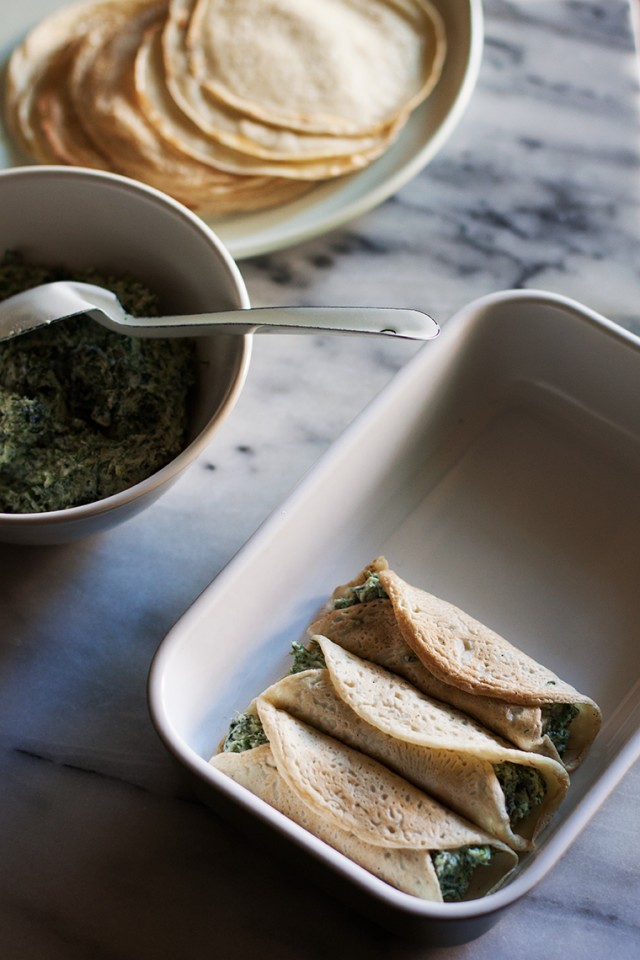
The problem, I was thinking, as I took home my bag of borage, is that I can’t decide what to make. There’s simply too much choice.
I consulted two of my favourite books that also happen to be cookbooks. Patience Gray’s Honey from a Weed and Luigi Ballerini’s A Feast of Weeds. Both had wonderful ideas for borage (and indeed many other edible, foraged plants). Ballerini’s in particular is an interesting one as it’s a “literary guide” to edible weeds — the chapter on borage starts with a description of the ancient use of borage as a natural mood enhancer and cure for melancholy (the Welsh name for borage, llawenlys, means “herb of happiness”) and includes a quote from Homer’s Odyssey (Helen slips it into the wine “to put an end to the endless whining of her husband, Menelaus”) as well as The Wizard of Oz. It’s impossible not to love, especially when he suggests a recipe for borrage and potato gnocchi.
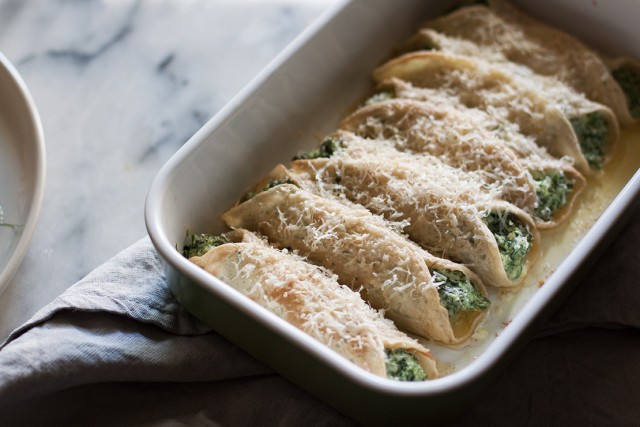
I finally decided, after reading in Ballerini’s book about a recipe for giant baked pasta shells stuffed with ricotta and borage, to make a stuffing with borage and other wild herbs to fill crepes. Not just any crepes, but tiny, impossibly thin ciaffagnoni, the specialty of the Maremman town of Manciano. The Mancianesi like to say that Catherine de’ Medici’s Parisian entourage of Tuscan chefs included one from Manciano — and that French crepes were born from ciaffagnoni. I had researched and tested these crepes for my cookbook, Acquacotta, but it wasn’t until I called upon some experts at the beautiful Villa Acquaviva, near the town of Manicano, that I truly understood the secret behind making and eating them.
They’re so delicate because they are made from just eggs, flour and water. The same ingredients as pasta, except for the fact that the ratio of water to flour is 2:1. So it’s even more fluid than regular crepe batter, which makes them notoriously difficult to make. I had to throw away my first attempts until I met Valentina Di Virginio, the matriarch and chef at her family’s Villa Acquaviva.
“The first ten will break,” she warned me. It’s more like three, but Valentina is used to making hundreds of these little crepes in miniature pans for their restaurant. She showed me how, as soon as the pan reaches the right temperature (which is hotter than you may think) that they no longer stick or break — as if by magic. You need to hear that chhhhhhhhhhh as soon as you pour in the batter, which will begin to bubble immediately.
She soon revealed more secrets. The batter needs to rest, overnight if possible, for it to become creamy. And her tool of choice for flipping the crepes? A toothpick. Yes. It’s a wonderful tool, actually, I can’t think of anything better — you run the pointed tip of the toothpick around the edges of the crepe to loosen it from the sides of the pan and then, poking the tip through the crepe gently, you lift it and flip it.
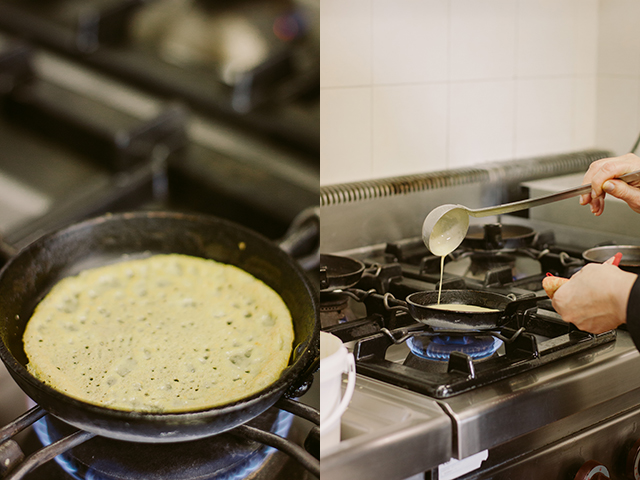

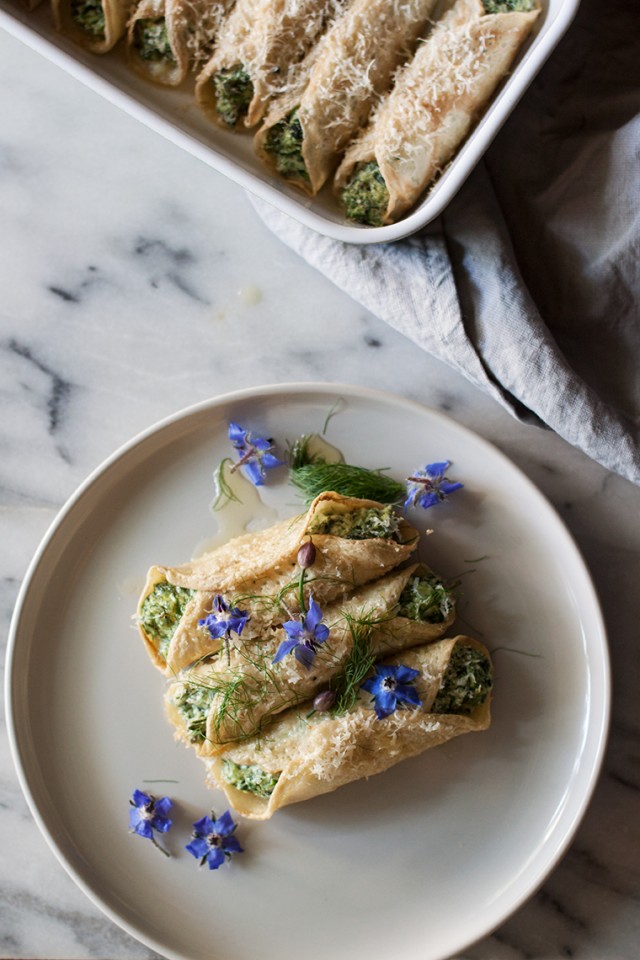
Borage and ricotta crepes
Ciaffagnoni di borragine e ricotta
Collect borage that you can be sure is away from polluted areas like roadsides (and hasn’t been used as a dog’s toilet). You may want to wear gloves when you collect and work with borage. It’s characteristic fuzziness is actually thanks to tiny prickles, not as bad as the ones on nettles, but almost. And unfortunately unlike nettles, they don’t lose their prickliness after blanching.
The recipe for these ciaffagnoni comes from my cookbook, Acquacotta, published by Hardie Grant Books. You won’t need all of the batter for this dish (about half will do for this) but with any leftovers, they freeze well, or will still be good the next day or two when wrapped well or kept in an airtight container in the refrigerator. Warm them gently and you can eat them sweet with honey and ricotta or with jam, or simply sprinkled with grated pecorino cheese as a snack.
For the ciaffagnoni:
- 3 eggs
- 150 grams plain flour
- 300 ml water
- 1 tablespoon olive oil, plus extra for greasing
For the filling:
- 300 grams of fresh borage leaves and flowers
- 400 grams of ricotta
- handful of wild fennel (or feathery fennel tops, or other favourite herbs), finely chopped
- small bunch of chives, finely chopped
- 1 egg
- zest of 1 lemon
- salt and pepper to taste
- 50 grams melted butter
- Handful of Parmesan or Pecorino cheese
For the ciaffagnoni, whisk together the eggs and flour until smooth. Add the water and oil and combine. Let the batter rest, overnight, or for several hours, in the fridge.
Heat a small pan (I used a 10cm wide pan) until very hot. Grease lightly with some olive oil. Give the batter a good stir and pour onto the pan, swirling quickly to just cover the surface of the pan thinly (for the 10cm wide pan, this is about 1 tablespoon of batter). The crepe should begin to bubble and cook immediately. When the top begins to look dry and you can run a toothpick around the edges easily, it’s usually a sign that it’s ready. Poke the toothpick gently through the crepe near an edge and flip it over. Cook briefly – 10 seconds – and then remove to a plate and continue with the rest of the crepes.
For the filling, wash the borage well, set the flowers aside and cook the borage leaves in a saucepan of salted, boiling water for three minutes. Plunge into cold water and drain very well, then chop (careful of the prickles) finely and squeeze as much water as you possibly can out of the borage. Place in a bowl with the rest of the ingredients except for the butter and Parmesan. Season well with salt and pepper.
Place a couple of tablespoons of filling along the centre of each crepe, then roll them up like a cigar – they should look a little like cannoli. Place them in a baking dish and continue until the dish is full. You should have about 20 small cigars for 4 people. Pour over the melted butter and sprinkle over the cheese, then bake for 10-12 minutes at 180C. If using larger crepes and more filling, you may need a couple extra minutes. Sprinkle with the borage flowers and serve.
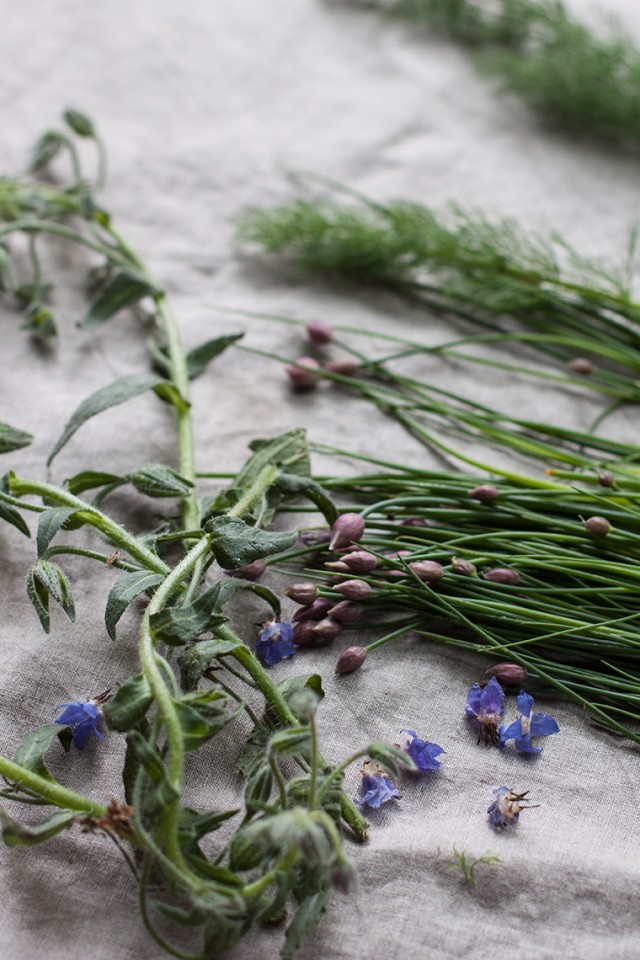
Original Website: Borage and ricotta crepes | Emiko Davies


 English
English  中文
中文